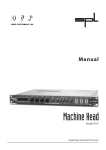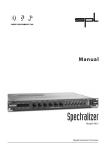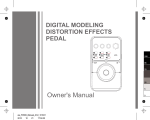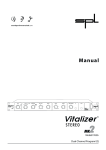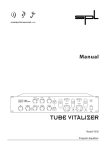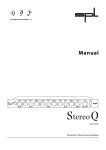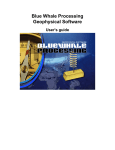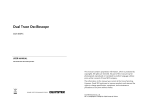Download Sound Performance Lab 9632 Stereo Equalizer User Manual
Transcript
Manual Loudness Maximizer Model 9632 Digital D ynamics Processor Loudness Maximizer Manual by Hermann Gier Version 3.1 – 9/1999 The information in this document has been carefully verified and is assumed to be correct. However Sound Performance Lab (SPL) reserves the right to modify the product described in this manual at any time. Changes without notice. This document is the property of SPL and may not be copied or reproduced in any manner, in part or full without the authorization of SPL. Limitations of Liability: In no event will SPL be liable for any damages, including loss of data, lost profits, cost of cover or other special, incidental, consequential or indirect damages arising from the use of the unit, however caused and on any theory of liability. This limitation will apply even if SPL or an authorized dealer has been advised of the possibility of such damage. SPL electronics GmbH P. O. Box 12 27 D- 41368 Niederkruechten, Germany Tel. +49 - (0)21 63 / 98 34-0 Fax +49 - (0)21 63 / 98 34-20 E-Mail: [email protected] www.spl-electronics.com © 1999 SPL electronics GmbH. All Rights Reserved. Model 9632 Foreword ................................................................................................... 3 Thanks........................................................................................................ 3 Introduction ............................................................................................. 4 Operation Safety..................................................................................... 5 Connections ............................................................................................. 6 Flow Chart ................................................................................................ 7 Contents Control Elements.................................................................................. 8 ACTIVE......................................................................................................... 8 DESIRED GAIN.......................................................................................... 8 SOFT-HARD .............................................................................................. 9 MORE DENSITY ........................................................................................ 9 BOOST .......................................................................................................10 LCD DISPLAY ............................................................................................10 LED CHAINS .............................................................................................10 PRESETS ....................................................................................................11 INFO ............................................................................................................12 Specifications ..........................................................................................17 Warranty ...................................................................................................18 Foreword Dear customer, Thank you for the confidence you have shown towards Sound Performance Lab by purchasing the SPL Loudness Maximizer. You have decided to use a tool of high performance which sets you in the position to have faster success and a better sound quality in your music productions and pre-masterings. As a typical SPL unit the Loudness Maximizer combines exemplary specifications and high manufacturing standard with excellent sound quality to provide you a precious component for studio and mastering purposes. Please read this manual carefully to ensure you have all the information you need to use the Loudness Maximizer. We wish you every success with your new Loudness Maximizer. Your Sound Performance Lab-Team I would like to start with my thanks to all our staff, who created what is to be described here. Special thanks go to Jörg Houpert, Jörg Mayer, Andreas Skäbe and Klaus-Peter Webersinke from Spectral Design, as well as Harald Obenland from Octum electronics. Thanks Our products are often tested and compared in many publications and by our customers themselfs and constantly valued with best results. I would like to pass on this broad appreciation to those, who deserve it – my excellent colleagues. Hermann Gier Loudness Maximizer 3 Introduction SPL’s digital audio processors are designed in cooperation with Spectral Design of Bremen, Germany, who are responsible for the DSP programming. Maximizing the subjective loudness without sound coloration Concept: The Loudness Maximizer is the first digital 19-inch dynamics processor to utilize new psycho-acoustic algorithms which are designed to maximize subjective loudness and to exploit effectively up to 99.9% of the available headroom with guaranteed clip-free performance. Even a normalized sound file can be made subjectively louder without changing the essential character of the sound, yet if the user wants even more loudness, the Loudness Maximizer can be coaxed into producing audible changes in the sound, which are optimized to be useful in a creative sound design context. A „look ahead“-signal analysis computes data for most unobstrusive limiting and compressing. The DSP-algorithm constantly analyzes the input signal and computes the data for the most unobtrusive dynamics processing using an algorithm developed from extensive psycho-acoustic and audiometric research. The dynamics processing is not simply limited to Peak-Limiting nor Compression, but is an intelligent combination of both, where the characteristics of the input signal determine the processing, interactively and automatically. The Compressor used within the Loudness Maximizer treats the audio as an entity and utilizes a static (no-knee) compression characteristic that operates without steps. The use of a multi-band design was specifically avoided, because splitting up audio into several bands, then remixing them after processing usually affects the coherence of the signal and causes intermodulation, resulting in sound coloration. The Limiter works after the Compressor and is designed to cut peak levels effectively by creating a minimum number of invalid samples.This is achieved by re-calculating the original peak-curve on a lower level, but maintaining its shape, where the Soft/Hard control provides access to the sound of the Limiter. Using the Soft position creates a rounded bell with virtually no invalid samples. You can gain more loudness by turning the control to Hard. Easy and intuitive operation Operation: The handling of the Loudness Maximizer is very easy. Only three control parameters and one switch function are necessary to adjust the loudness maximization process.Most of the parameters are set automatically by the programme material itself.The algorithms are optimized so that the process is as transparent as possible. DESIRED GAIN sets the maximum level change. Adjustable values range from 0dB to +15dB. The Done LED-bar shows how much of the desired gain change was achieved by the Loudness Maximizer. The Soft/Hard control adjusts the sound character of the Limiter. You can gain more loudness by turning the control to the Hard position, which increases the risk of audible distortion. The MORE DENSITY control allows to sweep from Peak-Limiter performance to Compressor performance. The higher the value the more compression is applied. The BOOST button increases loudness by an additional 2dB. 4 Loudness Maximizer Indications and Metering: The Loudness Maximizer is equipped with PPM meters for input and output that show the signal level with maximum resolution (0.01dB) just before 0dB. Input and Output PPM metering The Signal LED is the first LED in each PPM meter that lights up when a digital source is present at the inputs The Possible LED chain represents the first device to show how much subjective loudness can be gained. Initial settings for the DESIRED GAIN control are shown here. POSSIBLE-LED-bar shows how much subjective loudness can be gained The Done LED chain indicates the percentage of achieved gain change. It shows how much of the Desired gain setting was actually realized. The philosophy behind the digital audio processors is that they are designed to be operated like analogue units; there is only one INFO menu but no multi-function controls. The LCD readout simply shows the current encoder positions and the preset number. The encoders are built without clicks or detents, so they feel like analogue pots. Our DSP platform uses two Motorola 56002 DSPs running at 66 MHz. This enormous computational power guarantees real-time operation where sophisticated DSP algorithms will not be restricted by resource limitations. The general concept is that each digital processor should fulfill only one task, in the most effective way possible, and with a minimum of controls and switches. As much as possible should be automated to promote user-friendly operation – the external controls access only the sonically relevant parameters. Additionally all controls with a wide value range (e.g. 0 to 100) are programmed with an 'alpha-dial' logic. Turning the encoder rapidly causes the values to jump in steps of 10, whereas turning the encoder slowly causes the values to proceed in single increment steps. The housing of the Loudness Maximizer has the standard 19"EIA format and occupies 1U (44 mm) in your rack. When installing the unit in a 19"-rack, the rear side of the unit needs some support, especially in a touring case. The Loudness Maximizer should not be installed near units which produce strong magnetic fields or extreme heat. Do not install the Loudness Maximizer directly above or below power amplifiers. „Analogue“ control feeling The DSP Platform: Enormous computational power guaranteeing real-time operation User-friendly programmed software Operation Safety Check that the voltage details quoted on the back panel are the same as your local mains electricity supply. Use a minus (-) screwdriver to set the voltage selector to the voltage for the area in which the unit will be used. Never cover up the ventilation slots on the top of the unit. If, during operation, the sound is interrupted or indicators no longer illuminate, or if abnormal odor or smoke is detected, or if liquids are spilled on the unit, immediately disconnect the power cord plug and contact your dealer. Only clean your Loudness Maximizer with a soft, lint-free cloth. Loudness Maximizer 5 Connections Before connecting the Loudness Maximizer switch the power off at all connected units. The rear panel provides AES/EBU- and S/P-DIF-inputs and outputs. Any additional channel, status and user-bits are passed through unaltered, and the outputs can be used at the same time if required. The Loudness Maximizer operates with 24 bit word width. It accepts 16 bit and 20 bit inputs and will create output signals according to the input resolution. For synchronisation purposes Wordclock In and Wordclock Through BNC connectors are fitted with a switchable 75 Ohm termination. MIDI In and MIDI Through connectors allow presets to be selected via MIDI program change commands. For easy upgrade of future software releases, the rear panel offers RS-232 interface for PC and RS-422 interface for MAC. Installing Updates: Note: All presets will be lost after installing a new software version! 1. Connect your computer with the Loudness Maximizer via a serial port with a standard Z-modem cable. RS-232 for PC and RS422 for MAC. Rear view Loudness Maximizer, Model 9632 2. Open a terminal program like “Hyperterminal” on PC and make the following adjustments: Baud rate: 9600; Stop bit: 1; Parity: none; Data bit: 8; Handshake: no; Transfer mode: ZMODEM 6 3. Switch on the Loudness Maximizer and depress both Preset Up and Preset Down until the LC- display says “wait for Zmodem download“. 4. Load the update file into your terminal program and send it to the Loudness Maximizer.The LC-display shows the progress of the download in kB. 5. After successfully installing the new software version the LC-display says “download valid”. 6. Switch the Loudness Maximizer off and on. The new software version number is displayed in the first INFO page (simultaneously depress Store and Apply; also refer to Control Elements No. 9, INFO). 7.If an error occurred during download the LC-display says “download failed”. The Loudness Maximizer now waits for a new download. Please check all adjustments on your terminal program and try again. If you are still unsuccessful contact your local dealer. Loudness Maximizer All controls are in the start-off positions: Quick Start DESIRED GAIN 0; SOFT-HARD -9; MORE DENSITY 0. 1. Press ACTIVE. LED illuminates. 2. Watch the Possible LED chain and adjust the shown value with the DESIRED GAIN (for most unobstrusive operation the Possible LED chain should not show negative values. 3. If more loudness is wanted, turn the SOFT-HARD to higher values (i. e. -3).The Possible LED chain shows you the new free loudness headroom that you ad to the previously adjusted DESIRED GAIN value. 4. To increase the density of your source material turn up the MORE DENSITY control. AUDIO signal analysis Done display compressor Done:The LED bar shows how much % of the DESIRED GAIN have been realized Desired encoder The Compressor operates with a static (no-knee) characteristic for most unobstrusive compression Density encoder DESIRED GAIN: Adjusts the desired loudness increase limiter Soft/Hard encoder AUDIO Loudness Maximizer The signal analysis computes control data for the Compressor and Limiter and calculates the Possible as well as the Done loudness increase Possible:The LED bar shows the possible loudness increase Possible display Boost switch Flow Chart Density: Controls the amount of compression The Limiter is equipped with SOFT-HARD sound control and the BOOST function 7 Control Elements 6 5 2 3 Active 1 4 1 8 7 9 The ACTIVE function switches the Loudness Maximizer on or off. The illuminated LED indicates that the processing has been activated. The software bypass also compensates for the 5ms time delay between processed and unprocessed signal. The AES/EBU input and output are equipped with relay-hardbypass. In the event of a power failure the Loudness Maximizer is automatically switched to hard-bypass (power failure safety) without interrupting the data flow. Relay hard-bypass for AES/EBU input and output Desired Gain Adjusting the desired increase in loudness 2 DESIRED GAIN adjusts the desired loudness increase in dB. Adjustable values range from 0dB to +15dB.The value is shown in the LC-display (see 6). The Loudness Maximizer tries to increase the energy of the signal or the effective loudness, respectively, by the value entered. The DESIRED GAIN encoder is directly coupled with the Possible LED bar (see 7), which gives you an initial indication on the setting of the DESIRED GAIN encoder. The loudness increase cannot be displayed in standard level or peak meters.The Possible LED bar is especially designed to show the possible increase in subjective loudness. Even normalized audio files can effectively be increased in loudness without sound manipulation. Additionally the Done LED bar shows how much of the adjusted DESIRED GAIN have actually been achieved. Setting: To get a good starting position for the signal analysis a loud part of the signal should be played. Watch the Possible LED bar. For example: If it shows +3dB adjust 3dB with the DESIRED GAIN encoder. The Possible LED bar now shows 0dB. An initial loudness optimization without any sound manipulation is now already complete. 8 Loudness Maximizer You can gain more loudness and also start to manipulate sound when you choose other than the initial settings for SOFT-HARD (see 3) or MORE DENSITY (see 4). After having changed these parameters a readjustment of the DESIRED GAIN is mostly advisable. 2 Desired Gain The SOFT-HARD encoder controls the operation of the Limiter and influences the sound of the Loudness Maximizer. The control range is -9 (very soft) to +9 (very hard). The adjusted value is shown in the LC-display (details see 6). 3 Soft/Hard The higher the adjusted value the harder the sound becomes. The Loudness Maximizer will allow invalid samples possibly resulting in audible distortion. The Possible LED bar will show you increasing values (more subjective loudness to gain) the more the SOFT-HARD control is turned to hard. Use the DESIRED GAIN control to exploit the additional loudness. Defining the way the Limiter sounds and defining if invalid samples are allowed or not. Low SOFT-HARD values (i.e. -9 up to -5) let the Limiter recalculate the original curve on a lower level allowing no invalid samples at all. This way of operation is very unobstrusive but will not allow very high loudness maximizations. The setting of the SOFT-HARD control is an aesthetical question and extremely dependent on taste and the source material. Roughness, sharpness and distortion become audible when critical program material like classical music or single instruments that show almost sine-wave like waveforms are treated with Hard settings. In these cases set the SOFT-HARD control between -9 and -3. Music with a high density in high frequencies or complex signals can be treated with values between -6 and +3 without creating audible distortion. Uncritical material like dance floor productions, jingles or promos may be treated with values between 0 and +9. In comparison to other systems with soft and hard limiting the Loudness Maximizer does not produce additional harmonics.This phenomenon is a standard problem with other systems leading to increased sharpness and sound manipulation. Diagram The Loudness Maximizers Limiter does not produce harmonical distortion Loudness Maximizer 9 More Density 4 How do I restore output gain when heavy compression (MORE DENSITY) is applied? With the MORE DENSITY control you can change the principle behaviour of the control loop of the Loudness Maximizer. This parameter describes the Compressor-to-Limiter proportion. In addition, internal rules and algorithms will be changed, too. The higher the MORE DENSITY setting is the more “work” will be done by the Compressor. If MORE DENSITY is set to 0 only the Limiter is operating. If MORE DENSITY is set to 24 only the Compressor will be working leaving the Limiter active as peak protection. The adjusted value is displayed in the LC-display (see 6). Adjustment: The MORE DENSITY control should be adjusted carefully for mastering tasks. Since there is always a need for a compromise between limiting and compression there can be no optimum adjustment. 0 to 10 are good starting values. When the MORE DENSITY control is set to 24 the Loudness Maximizer tries to gain loudness only by compression. In this case the overall level starts to decrease as the compressor pulls high levels down and lifts up low-level parts of the signal. Advice: If you want to compress audio heavily here is a tip on how to maintain maximum output level: Example: DESIRED GAIN 8 dB, More Density12. This MORE DENSITY setting reduces maximum output level by ca. 2-3 dB. To compensate for the level difference make these adjustments: DESIRED GAIN 11 dB, MORE DENSITY 8. Result: The compression remains the same and the maximum output level is maintained. Boost 5 The BOOST button (some call it the “client button”) gives the definite kick to the signal. It increases the loudness by another 2dB, regardless of any other adjustments. Using the BOOST button is very much depending on the program material. Using it with Trance/Techno, or jingles etc. is uncritical. Some Pop/Rock productions might benefit as well. It is definitely a nice tool to create very impressive samples. In the tradition of impressing clients who just want more and more this button does the job well. LC-Display 6 The LC-display shows all encoder settings and the number of the preset being used in the last session with the Loudness Maximizer (for details on Presets refer to 8). More information is displayed when activating the INFO pages (see 9). Press Store and Apply for 1 sec. to enter the INFO pages. 10 Loudness Maximizer The Input and Output LED chains are PPM (peak level) meters. By evaluating both LED chains an approximated effective loudness increase can be estimated. The LED chains have a very fine resolution before 0dB. The 0dB position is actually showing 0.01dB which represents the last possible output value of the Loudness Maximizer. No clipping is possible within the algorithm of the Loudness Maximizer. 7 LED-Anzeigen The first LED in each Input and Output PPM meter is a signal (Sig.) LED to indicate that a valid digital source is connected and detected. This LED helps you to verify the signal flow within a digital processing chain. If one Sig LED is not illuminating you have a first indication of a faulty digital signal flow. The last LED of each Input and Output PPM meter is a Clip LED. The LED illuminates if the digital signal is too hot causing digital distortion. Warning: Some level meters (even in digital products) show clipping striking below 0dB (full scale).You can trust the Loudness Maximizer. The PPM meters show peak levels with a precision of up to 0.01dB (0dB on scale).The internal precision is even higher. We consider the Possible LED chain the first measuring instrument for analysing a possible loudness improvement at all. For measuring this parameter the input material has to be analyzed precisely. By combining this analysis with the parameters DESIRED GAIN and SOFT-HARD, it is possible to compute the loudness yet available in real-time. The Done LED chain shows how many per cents of the DESIRED GAIN have been gained currently. When adjusting the Loudness Maximizer this value should not be under 50% permanently. The display especially reacts on the MORE DENSITY control as well as on the stucture of the source material. When the MORE DENSITY value is greater than 10, The Done LED chain may possibly show values between 60% to 90% permanently. This will only indicate that the compressor is working within its static curve. Using the metering: If your general attitude towards loudness maximization is to do this job with no audible side-effects, the Possible LED chain should not show negative values and the Done LED chain should shows values between 90 % and 100 %, indicating that the processors can realize what you desired. The harder you set the Limiter´s operation the more loudness can be gained. Once you leave the -9 to -5 positions of the SOFTHARD control moving up to 0 or above you will have effects on the overall sound. If you want to compress your audio heavily you should drive the DESIRED GAIN up even if the Possible LED chain shows negative values or the Done LED chains drops down to i.e. 50%. Doing this allows you to create audible compression effects. Sometimes this is just what you want and very rarely achieveable with digital compressors. Loudness Maximizer 11 Presets 8 Storing a preset: Depress Store for1 sec. – LED flashes; use Up/Down to select preset number; depress Store again – LED goes out, preset is stored The Loudness Maximizer allows you to store up to 99 presets, which can be changed by MIDI program change command. If you want to store a new adjustment, depress Store for one second. The LED starts to flash indicating that the Store mode has been activated. The LC-display now shows the values of the presets (including the BOOST function) before the Loudness Maximizer was switched off the last time. Use Up and Down to select a new preset number.The status-LED flashes shortly to indicate that the input (depressing Up or Down) is accepted. Keeping Up or Down depressed will let you jump through the preset list in steps of 5 presets. Once a new preset location is found depress Store again. The Store LED goes out. The preset is stored at the new location. In case you want to quit the Store mode without storing the new adjustments simply press Apply. Applying a preset: Depress Apply for1 sec – LED flashes; use Up/Down to select preset number; depress Apply again – LED goes out, preset is applied If you want to apply various presets depress Apply for one second. The Apply LED starts to flash indicating that the Apply mode is activated. You can step through the preset list with Up and Down. Once you have a preset that you want to apply depress Apply again. The Apply LED goes out indicating that the preset is applied. In case you want to quit the Apply mode without applying the new preset simply press Store. To increase operation safety it is impossible to apply presets by simply depressing Up or Down.The Up and Down status-LEDs will not flash indicating that the input is not accepted. You have to depress Store or Apply for one second in order to activate the Up and Down buttons. Operation safety: Presets can not be changed by accident Info 12 9 Depressing Store and Apply simultanouesly for about one second gets you into a hardware dialogue, called INFO. The LCdisplay shows status informations of the digital data stream. With Up/Down you will jump from one page to the next or previous. If a selection is provided use Apply to select. Loudness Maximizer 1. Software version and date 9 Info 2.Selecting inputs: The Loudness Maximizer automatically searches for an input signal. If both inputs are connected the AES/EBU input will be selected first. If you want to select the S/P-DIF input you have to call up the INFO pages: AES/EBU input detected. Or: no AES/EBU input detected. Press APPLY (if AES/EBU is detected): AES/EBU input with wordclock detected. Or: AES/EBU input without wordclock detected. Press APPLY: S/P-DIF input detected. Loudness Maximizer 13 Info 9 Or: no S/P-DIF input detected. Press APPLY (if S/P-DIF is detected): S/P-DIF input with wordclock detected. Or: S/P-DIF input with wordclock detected. 3. Displaying the detected sample frequency: The Sample Frequency will be detected automatically. The display either shows 44,1 kHz, 48 kHz or 32 kHz. 4. Displaying the audio error flag: No = no error detected; Yes = error detected. 5. Displaying the CRC-Error flag: No = no error detected; Yes = error detected. 14 Loudness Maximizer 6. Displaying the Channel Difference Error flag: 9 Info No = no error detected; Yes = error detected. 7. Setting or erasing the Copy-Prohibit flag: No = flag erased or not set; Yes = flag set. Pressing APPLY switches off a set Copy-Prohibit flag. It is not possible to set a Copy-Prohibit flag, if there is no Copy Prohibit flag in the processed data. 8. Displaying the Original flag: No = no Original flag; Yes = Original. 9. Displaying the Emphasis flag: No = no emphasis; Yes = with emphasis. 10. Selecting a serial port: RS 232 interface for update-download from PC. Or (Press APPLY): RS 422 interface for update-download from MAC. Loudness Maximizer 15 Info 9 11. Selecting a MIDI channel: Depress APPLY to step from channel 01 up to channel 16. In order to increase operation safety only send the necessary MIDI data to the Loudness Maximizer. Unnecessary information might lead to system failure. You can use MIDI to create a MIDI fade out, if you are working with a digital console that does not provide master inserts.The Up and Down LEDs illuminate indicating that a volume change command is received. You can also switch between presets with the MIDI program change command. This can especially be useful, when you are mastering a song, for example, that requires different settings for chorus, refrain, or bridge. The Apply LED illuminates indicating that a program change command is received. MIDI IMPLEMENTATIONS Function Received Data Note Basic Channel: Change 1-16 stored Control Change: 7 1-127 Volume 0-99 real value Program Change: 12. Adjusting the maximum output level: In certain applications (i.e. recording to Sony Digital-Beta: 2dBfs) it may be important to maximize loudness to a specific output level that is below the full scale level.The Output Level can be set to a lower level than 0dB. The default position is 0dBfs, which can be attenuated to -12dB in steps of 0.5dB. You can change the Output Level in the INFO pages. Adjust the Output Level with the DESIRED GAIN encoder, which has to activated by depressing the Apply button first. 16 Loudness Maximizer Adjusted output levels will be stored and will be active the next time you boot the Loudness Maximizer. If you recognize that your unit does not maximize to full scale, please check the Output Level parameter first. 9 Info The Output Level attenuation is not shown in the Output PPM meters! Tip: The Output Level should only be used where the output signal should permanently be lower than 0dB. The Output Level setting will be ignored when a MIDI volume change command is present. MIDI has first priority. Note that the setting in the Output Level page will still show the reduced output level, nevertheless, a MIDI volume change command may already have reset the output level to a different value. Therefore, if you use MIDI set Output Level to 0dB. You leave the INFO pages by depressing STORE. Loudness Maximizer 17 Specifications Input/Output Sample rate frequency 32-48 kHz, automatic detection AES/EBU, twisted pair (1), AES 3 AES/EBU in- & output impedance: 110 Ohms S/P-DIF, co-axial (2), SPDIF-2 S/P-DIF input impedance: 75 Ohms Wordclock In/Through, co-axial, BNC Wordclock in-/output impedance: 75 Ohms MIDI In/Through: yes RS 232 (PC): yes RS 422 (MAC, max +/- 14 V): yes Free download at www.spl-electronics.com Clip display,Input transformer (AES/EBU), Output transformer (AES/EBU), Relay Hard Bypass (AES/EBU) Measurements AES/EBU: Jitter 1ns S/P-DIF: Jitter 3 ns Wordclock In: Jitter 1,5 ns Power supply Torroidal transformer, 60 VA Fuse: 1A/slow blow GND-Lift switch: yes Voltage selector 115 V/230 V Dimensions: 19"/1U; 482 x 44,45 x 350 mm Weight: 4,9 kg (1) AES/EBU is defined for levels from 2 V to 7 V Measurements AES/EBU: 4,4 V with load (2) S/P-DIF is defined for levels from 200 mV to 700 mV Measurements S/P-DIF: 500 mV with load Subject to change without notice. 18 Loudness Maximizer SPL electronics GmbH (hereafter called SPL) products are warranted only in the country where purchased, through the authorized SPL distributor in that country, against defects in material or workmanship. The specific period of this limited warranty shall be that which is described to the original retail purchaser by the authorized SPL dealer or distributor at the time of purchase. Warranty SPL does not, however, warrant its products against any and all defects: 1) arising out of materials or workmanship not provided or furnished by SPL, or 2) resulting from abnormal use of the product or use in violation of instructions, or 3) in products repaired or serviced by other than authorized SPL repair facilities, or 4) in products with removed or defaced serial numbers, or 5) in components or parts or products expressly warranted by another manufacturer. SPL agrees, through the applicable authorized distributor, to repair or replace defects covered by this limited warranty with parts or products of original or improved design, at its option in each respect, if the defective product is shipped prior to the end of the warranty period to the designated authorized SPL warranty repair facility in the country where purchased, or to the SPL factory in Germany, in the original packaging or a replacement supplied by SPL, with all transportation costs and full insurance paid each way by the purchaser or owner. All remedies and the measure of damages are limited to the above services. It is possible that economic loss or injury to person or property may result from the failure of the product; however, even if SPL has been advised of this possibility, this limited warranty does not cover any such consequential or incidental damages. Some states or countries do not allow the limitations or exclusion of incidental or consequential damages, so the above limitation may not apply to you. Any and all warranties, express or implied, arising by law, course of dealing, course of performance, usage of trade, or otherwise, including but not limited to implied warranties of merchantability and fitness for particular, are limited to a period of 1 (one) year from either the date of manufacture. Some states or countries do not allow limitations on how long an implied warranty lasts, so the above limitations may not apply to you. This limited warranty gives you specific legal rights, and you may also have other rights which vary from state to state, country to country. SPL electronics GmbH 41372 Niederkruechten, Germany Loudness Maximizer 19



















